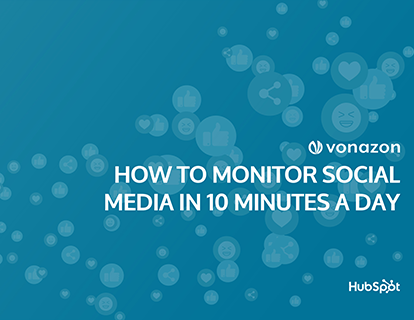
9 Social Media Marketing Strategies to Generate Leads
Social media’s role in the business world is enormous and only growing. Harnessing social media has become a necessity to grow a business and maintain a connection with your audience. Social media has also become one of the most valuable platforms in which companies generate leads. In this article we share nine of our favorite social media lead generation strategies so you can put your brand in front of the right people.
Align your social media marketing goals with business objectives
Your social media content and marketing efforts should be an extension of your business and its core values and objectives. Business goals can be approached on social media by utilizing the SMART goal method which provides a framework to ensure your content is specific, measurable, achievable, relevant, and timely. Using the SMART method as a guide to creating your social media content helps produce effective content that reflects your business objectives and is attractive to your audience.

Know your audience
It’s vital to have a thorough understanding of all facets of your audience. Companies should possess knowledge about their audience’s age, interests, and geographical locations and have target audiences segmented into different buyer personas. Separate your audience into different segments and adjust your tone and design style to what you feel will resonate with them best. Characteristics of an audience can also differ from platform to platform. For example, your tone and content on Instagram may be more casual and humorous than what you post on LinkedIn, a platform with a more professional environment.
Evaluate the competition
Performing an evaluation of your competition can provide valuable insights that help create effective social media lead generation strategies. Research what is working for your competition, and what is not performing well. Evaluate competition design style, content tone, and interaction levels to gain a solid understanding of what may produce results in your industry. This can also help you find leads who are already interested in your product or service.
Perform a social media audit
A social media audit involves taking an in-depth look and analyzing your social media accounts on each platform. If you have yet to enter a particular social media platform, perform an audit by examining your competition and other successful brands in your industry. For new and existing accounts, ensure that all company information such as website, phone number, and location is current and accurate. It’s also important to maintain a sense of consistency throughout all branding and design on your social media profiles. Finally, use this audit as an opportunity to closely examine your metrics and professional insights for each platform. Look for areas of opportunity and fine-tune your content by assessing what works and what doesn’t.
Develop a plan for each social media platform
As previously stated, your content should differ slightly on each platform to reflect its tone and audience. Before going live with your social media marketing campaign, ensure that you have a unique plan for each platform that you feel will be most effective. Your plan should also include the length and frequency of your posts. For example, posting multiple times in a day is considered normal on Twitter, but may produce unfavorable results on Instagram. Additionally, your Twitter posts are limited to 280 characters, while Instagram allows for much lengthier posts with a character limit of 2,200.
Stay on brand
Maintaining brand consistency is key for streamlining your social media profiles. In today’s digital age, many consumers develop their entire perception of a company through social media. That’s why it’s important for your social media profiles to accurately reflect your brand. This involves the tone and design of your content. A good example of this is T-Mobile with its tone and use of its signature pink. This eye-catching pink has become synonymous with T-Mobile and is used throughout their physical locations, website, and social media. Additionally, their casual tone is consistent on their website, social media, physical advertising, and commercials.
Create a social media content calendar
Due to factors like social media algorithms, how often you post can be just as important as the content in the post. Most social media platforms favor balanced consistency with post duration and look unfavorably at posting too frequently or not frequently enough. A social media content calendar is a useful and valuable tool that can help create a reliable and consistent posting schedule. CAdditionally, creating a social media content calendar can help you brings your readers through a well-structured journey that introduces them to orand educates them about a product, service, or the brand itself. Not to mention the significant time saved by already having your social media posts ready to go and not needing to create, write, and design a post every day.
Make compelling content
Creating a post on social media does not guarantee that it will be seen by all your followers. In fact, typically only 10% of your followers will see your posts. Social media platforms use algorithms to determine what content is most intriguing to users, and favor that content heavily on users feeds. Social media platforms use engagement as the most significant factor when determining which posts will be most prominently featured on other users feeds. Engagement refers to how long users spend looking at your posts, and if they are engaging in the form of a “like”, comment, or share. The more engagement, the more favorable your content is for social media algorithms. The most compelling and thought-and-discussion-provoking content is what produces the most engagement.
Produce engaging content that encourages discussion among your readers. This will naturally put your posts higher on followers’ feeds and explore pages, bringing more eyes to your content and increasing social media lead generation.

Track performance and adjust plan accordingly
Most social media platforms contain valuable tools that provide in-depth interaction and performance insights. Use this to find out what is performing well, and where adjustments can be made. Examine your insights for each different platform to discover opportunities for improvement, and to better understand the nuances of your audience on all the different social media platforms.
Harness The Power
Social media has immense power, including the ability to completely transform your brand, gain exposure at a higher rate than paid advertising, and interact and develop relationships with your audience. Additionally, social media lead generation can be performed extremely effectively by aligning your social media with your marketing goals, knowing your audience, researching your competition, creating compelling content that is organized with a calendar, and tracking your results. Check out our free guide on how to monitor social media in ten minutes a day so you can utilize the methods and tips shared in this article in an efficient way.
WHAT’S IN THE GUIDE?
Work smarter, not harder, and save more time. It’s so easy to start. You could begin today! You’ll learn:
- What you should be monitoring on Twitter, Facebook, LinkedIn, Google+ & Quora
- What tools will help you consolidate your social media information
- How other marketers are spending time on social media
- Why monitoring matters
Account Executive
Vonazon Inc.

Vonazon can guide you through the process of creating fun and effective short form videos that are unique to your brand. We can also help you create campaigns around your videos that deliver results, grow your brand’s social media presence, and produce more leads.
Contact us today to begin your short form video journey.
Recent Posts
Categories
Categories
- ABM
- Account Management
- Analytics
- Artificial Intelligence
- Content Marketing
- Creative
- CRM
- Design
- eCommerce
- Email Marketing
- HubSpot
- HubSpot CRM
- HubSpot Marketing Hub
- HubSpot Partner
- Inbound Marketing
- Integrations and Migrations
- Lead Generation
- Lead Scoring
- Marketing
- Marketing Automation
- Marketing Strategy
- Native Advertising
- Omnichannel Marketing
- Organization
- PPC
- Programmatic Advertising
- Sales and Marketing Alignment
- SEO
- Social Media
- Staffing
- Trade Shows
- Videos
- Web Development
- Webinars
HOW CAN We
HELP YOU?
Lorem ipsum dolor sit amet, consectetur adipiscing elit.





